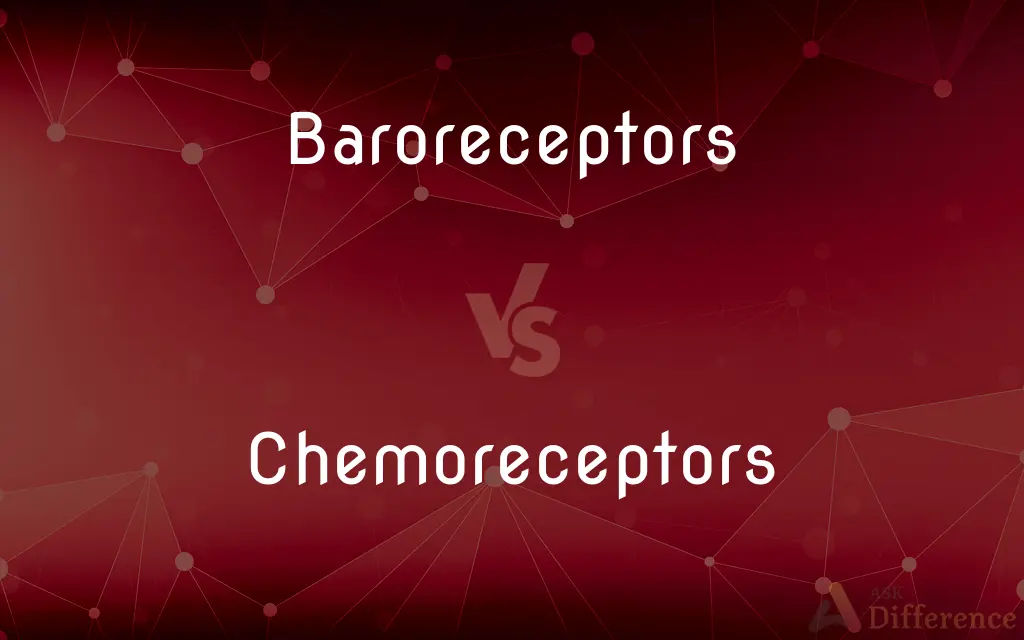Baroreceptors vs. Chemoreceptors — What's the Difference?
By Tayyaba Rehman — Published on November 4, 2023
Baroreceptors sense blood pressure changes; Chemoreceptors detect chemical concentrations in the environment or body.

Difference Between Baroreceptors and Chemoreceptors
Table of Contents
ADVERTISEMENT
Key Differences
Baroreceptors are specialized sensory neurons primarily located in blood vessels and the heart, particularly in the carotid sinuses and the aortic arch. Their primary function is to sense changes in blood pressure. When there's an alteration in blood pressure, Baroreceptors send signals to the brain, which then implements responses to stabilize the blood pressure. Chemoreceptors, conversely, are sensory receptors that detect chemical compositions either within the body or in the external environment. These receptors play crucial roles in various physiological processes, such as the regulation of breathing rate by sensing the concentration of oxygen and carbon dioxide in the blood.
Baroreceptors, by their nature, respond to mechanical changes, particularly those of the blood vessels. When these blood vessels stretch due to an increase or decrease in blood pressure, Baroreceptors activate and signal the central nervous system. Chemoreceptors, on the other hand, have the primary task of responding to the presence or change in concentration of specific chemicals. For instance, peripheral Chemoreceptors in the carotid and aortic bodies sense changes in blood pH, oxygen, and carbon dioxide levels.
The importance of Baroreceptors in maintaining homeostasis cannot be understated. By continuously monitoring blood pressure, they help the body to maintain a steady circulatory system, ensuring that organs receive adequate blood supply. Chemoreceptors, while also essential for homeostasis, contribute by ensuring that the body's internal environment, particularly concerning gas exchange and metabolic processes, remains stable. They are vital for breathing regulation and metabolic activities.
In some conditions, the functioning of Baroreceptors and Chemoreceptors can be compromised. For Baroreceptors, certain cardiovascular diseases might hinder their ability to accurately sense blood pressure changes. As for Chemoreceptors, certain toxins or diseases can impair their chemical sensing abilities, potentially leading to respiratory or metabolic issues.
Comparison Chart
Function
Sense blood pressure changes
Detect chemical concentrations
ADVERTISEMENT
Location
Primarily in blood vessels and heart
Throughout the body and in certain external locations
Stimulus Type
Mechanical (changes in blood vessel stretch)
Chemical (changes in chemical concentration)
Role in Homeostasis
Helps maintain stable blood pressure
Assists in regulating breathing and metabolic processes
Associated Conditions
Cardiovascular diseases
Respiratory or metabolic disorders
Compare with Definitions
Baroreceptors
Primarily located in the carotid sinuses and aortic arch.
The carotid sinuses house Baroreceptors sensitive to arterial pressure changes.
Chemoreceptors
Respond to changes in the internal or external environment.
Taste buds are Chemoreceptors that respond to different flavors.
Baroreceptors
Sensory neurons that detect blood pressure changes.
When blood pressure rises, Baroreceptors activate to signal the brain.
Chemoreceptors
Aid in maintaining metabolic homeostasis.
Chemoreceptors in the body help regulate pH by sensing acid levels.
Baroreceptors
Respond to the stretching of blood vessels.
The stretching of an artery's walls triggers the Baroreceptors within.
Chemoreceptors
Can be affected by certain toxins or diseases.
Toxins in the environment can sometimes impair the function of Chemoreceptors.
Baroreceptors
Play a role in cardiovascular homeostasis.
Baroreceptors ensure organs receive consistent blood flow by maintaining steady pressure.
Chemoreceptors
Detect specific chemical concentrations.
Chemoreceptors in the nose help in sensing different odors.
Baroreceptors
Can be compromised by certain cardiovascular conditions.
In some hypertension cases, Baroreceptors might not function optimally.
Chemoreceptors
Play a role in breathing regulation.
Chemoreceptors sense blood's oxygen levels to adjust breathing rate.
Baroreceptors
A sensory nerve ending that is stimulated by changes in pressure, especially one in the walls of blood vessels such as the carotid sinus.
Chemoreceptors
A sensory nerve cell or sense organ, as of smell or taste, that responds to chemical stimuli.
Baroreceptors
Plural of baroreceptor
Chemoreceptors
Plural of chemoreceptor
Common Curiosities
Where are Chemoreceptors commonly found?
Chemoreceptors are found throughout the body and in certain external locations like the nose.
What stimulates Baroreceptors?
Baroreceptors are stimulated by mechanical changes, especially the stretching of blood vessels.
How do Chemoreceptors aid in respiration?
Chemoreceptors sense oxygen and carbon dioxide levels in the blood, helping regulate breathing.
What do Baroreceptors primarily sense?
Baroreceptors primarily sense changes in blood pressure.
How do Baroreceptors help in maintaining homeostasis?
Baroreceptors help maintain stable blood pressure, ensuring consistent blood flow to organs.
Are taste buds a type of Chemoreceptor?
Yes, taste buds are Chemoreceptors that detect specific flavors.
Can diseases affect the functioning of Baroreceptors?
Yes, certain cardiovascular diseases can compromise Baroreceptor function.
How do Baroreceptors respond to a drop in blood pressure?
They send signals to the brain, which then initiates responses to raise the blood pressure.
Do Chemoreceptors only detect harmful chemicals?
No, Chemoreceptors detect a wide range of chemicals, not just harmful ones.
Are Baroreceptors found only in the heart?
No, Baroreceptors are mainly in the heart and blood vessels, especially the carotid sinuses and aortic arch.
What's the role of Chemoreceptors in taste?
Chemoreceptors in taste buds detect different chemical compositions, allowing us to sense flavors.
Share Your Discovery

Previous Comparison
Persian Gulf vs. Arabian Sea
Next Comparison
Meet vs. Meet WithAuthor Spotlight
Written by
Tayyaba RehmanTayyaba Rehman is a distinguished writer, currently serving as a primary contributor to askdifference.com. As a researcher in semantics and etymology, Tayyaba's passion for the complexity of languages and their distinctions has found a perfect home on the platform. Tayyaba delves into the intricacies of language, distinguishing between commonly confused words and phrases, thereby providing clarity for readers worldwide.
















































